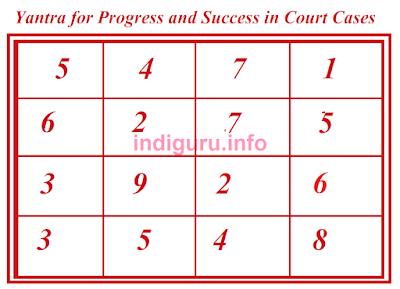This article describes two mystical Hindu Yantras having unbelievable powers of attracting Positive Vibrations and granting Money, Power, Rapid Rise in Career and Victory in Court Cases to the wearer of the Yantras.
The spell-caster can make and use any one of these Indian Charms or even both of them depending upon his needs. The technique of making and using these mystical Yantras has been described below:
Yantra for Money and Power: The benefits of wearing this Dhan Akarshan Yantra around the neck as a Good Luck Charm will give you success in gathering money, wealth and desired landed and movable property and become an affluent person with deep pockets and enjoy life to the fullest.

This Magic Yantra will make the wearer a high powered and important person and make him progress quickly in job, business or politics and gain all the perks of being in a powerful position.
Yantra for Success in Court Cases and Rapid Growth in Job or Business: This is a Occult Yantra having unbelievable mystical powers of giving victory and success in court cases, and all kinds of debates and arguments.

The Yantra also gives rapid promotions in employment or in the organization in which the wearer of the Yantra is working. This Success Yantra should will be more productive if it is made and used on a Tuesday.
The Method of Making these Yantras: The method of making these Yantras is the same and they must be made on Bhojpatra or White Paper with Ashtagandha Ink that should be prepared by mixing few drops of water with Ashtaganda Powder. A pointed stick or object can be used to write the Yantras.
The Yantras must be energized by burning incense and oil lamp before them and Praying to the Divine Powers of the Universe for success. Then, they can be used by putting them in a locket and wearing them around the neck.
The spell-caster can make and use any one of these Indian Charms or even both of them depending upon his needs. The technique of making and using these mystical Yantras has been described below:
Yantra for Money and Power: The benefits of wearing this Dhan Akarshan Yantra around the neck as a Good Luck Charm will give you success in gathering money, wealth and desired landed and movable property and become an affluent person with deep pockets and enjoy life to the fullest.

This Magic Yantra will make the wearer a high powered and important person and make him progress quickly in job, business or politics and gain all the perks of being in a powerful position.
Yantra for Success in Court Cases and Rapid Growth in Job or Business: This is a Occult Yantra having unbelievable mystical powers of giving victory and success in court cases, and all kinds of debates and arguments.

The Yantra also gives rapid promotions in employment or in the organization in which the wearer of the Yantra is working. This Success Yantra should will be more productive if it is made and used on a Tuesday.
The Method of Making these Yantras: The method of making these Yantras is the same and they must be made on Bhojpatra or White Paper with Ashtagandha Ink that should be prepared by mixing few drops of water with Ashtaganda Powder. A pointed stick or object can be used to write the Yantras.
The Yantras must be energized by burning incense and oil lamp before them and Praying to the Divine Powers of the Universe for success. Then, they can be used by putting them in a locket and wearing them around the neck.
Comments
Post a Comment